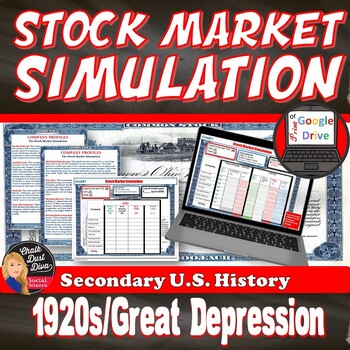STOCK MARKET Simulation Game | 1920s & Great Depression | Print & Digital
- Zip
- Google Apps™

What educators are saying
Also included in
- This product includes everything you need to teach an entire unit on “The Twenties” for your secondary U.S. History class. Common-Core aligned! Both Print & Digital (Google drive) versions are included! Buyer Feedback:Love the variety of all these resources - so many different activities to keepPrice $26.18Original Price $32.73Save $6.55
- This product includes everything you need to teach first semester, secondary (middle school or high school) American History class. Both Print & Digital (Google Docs) versions are included! Buyer Feedback:"As always, great activities and jammed packed with wonderful activities!”*This product incPrice $139.62Original Price $199.46Save $59.84
Description
This is a fun and interactive STOCK MARKET Simulation game to play with your secondary U.S. History students when studying the causes of the Great Depression.
The presentation begins with an engaging introduction to the stock market. Very detailed directions are then given to play the stock market simulation game. Students will begin by choosing stocks to purchase from a list of companies that existed in the 1920s. They will then complete the corresponding worksheet with the stock they purchased.
Buyer feedback:
“My students LOVED this! Every day they were super excited to see what happened with their stocks. It really helped them understand how stocks work today and how the Great Depression started.“ Hannah“My students LOVED this! Every day they were super excited to see what happened with their stocks. It really helped them understand how stocks work today and how the Great Depression started.“ Hannah
When they enter the classroom for the next six days, a new set of stock prices will be displayed for the years 1923-1929. Also included is a short description of the current situation for each company for the year displayed. Each day they will calculate their total loss or profit. To make it VERY easy, no buying or selling of the stock is allowed.
The last year is 1929 and many of them will be shocked at the dramatic decline in their stock price. The student who gained the most profit (or lost the least amount) will be declared the winner! A set of review questions to assess your students about what they learned are included. VERY specific directions are also included for both the teacher and the student.
Buyer Feedback:
"My students had a lot of fun with this activity. Actually, the students who are usually the least enthusiastic about history were some of the most involved! It was great!" Sonny
*Please download the PREVIEW to see everything that is included.
This purchase includes the following:
- Detailed Lesson Plan
- 40-slide PRESENTATION (Google Slides, PowerPoint, Editable)
- 4-page worksheet: The Stock Market Game (an example is included to use while modeling) (printable and digital)
- 2-page Company Prospectus (1920s Companies)
- Link to film clip: How the Stock Market Works
*This product includes a print and digital version compatible with Google Classroom. Both teacher and student directions are included. Simply share the resources with your students via Google or Google Classroom. Students will be able to type directly into the document.*
California Standards: 11.6.1 Describe the monetary issues of the late nineteenth and early twentieth centuries that gave rise to the establishment of the Federal Reserve and the weaknesses in key sectors of the economy in the late 1920s.
*updated 4-21-23
*************************************************************************************************
You may also be interested in:
⭐The Causes of the Great Depression DBQ
*************************************************************************************************
Let’s Connect:
EMAIL LIST Get a FREE product that includes 70 teaching strategies!
To follow my store, simply click “follow me” under Chalk Dust Diva at the top of my store page. You will be the first to receive notifications when I post new products and have sales.
Pay with a Purchase Order!
At checkout, click edit if you need more than one product. You can purchase additional classroom licenses at a reduced cost. Then, click on checkout. At the top, click on the Purchase Order tab. Follow the instructions for the P.O. TpT will save your order and when the P.O. is received, your downloads will be available for you on the website. You will receive an email that will let you know when payment has been received.
Leave Feedback and Earn Credits
Don’t forget to leave feedback after you purchase a product! Leaving feedback also earns you "credits" which can be used for discounts on future purchases. I would very much appreciate your positive feedback!







